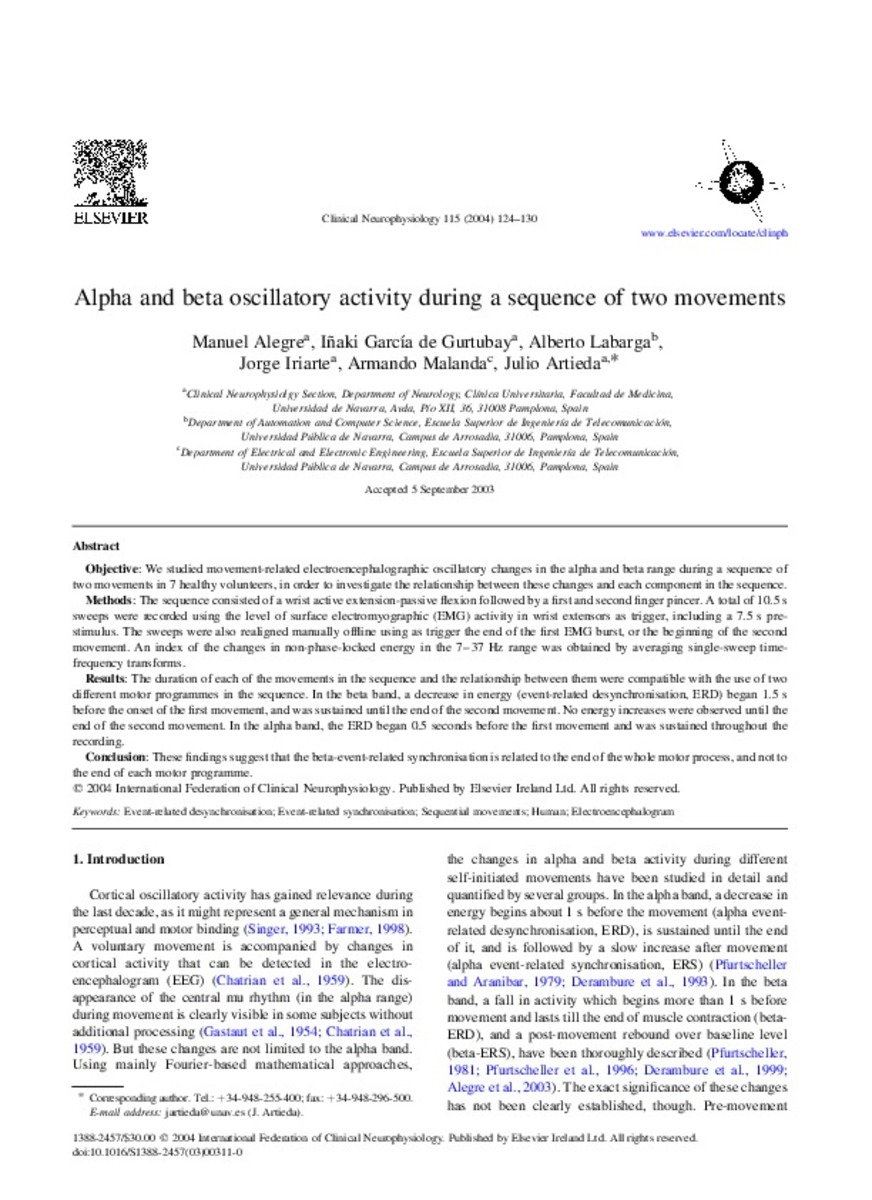Full metadata record
| DC Field | Value | Language |
|---|---|---|
| dc.creator | Alegre-Esteban, M. (Manuel) | - |
| dc.creator | Garcia-de-Gurtubay, I. (Iñaki) | - |
| dc.creator | Labarga, A. (Alberto) | - |
| dc.creator | Iriarte, J. (Jorge) | - |
| dc.creator | Malanda-Trigueros, A. (Armando) | - |
| dc.creator | Artieda, J. (Julio) | - |
| dc.date.accessioned | 2012-09-24T12:45:39Z | - |
| dc.date.available | 2012-09-24T12:45:39Z | - |
| dc.date.issued | 2004 | - |
| dc.identifier.citation | Alegre M, de Gurtubay IG, Labarga A, Iriarte J, Malanda A, Artieda J. Alpha and beta oscillatory activity during a sequence of two movements. Clin Neurophysiol 2004 Jan;115(1):124-130. | es_ES |
| dc.identifier.issn | 1872-8952 | - |
| dc.identifier.uri | https://hdl.handle.net/10171/23172 | - |
| dc.description.abstract | OBJECTIVE: We studied movement-related electroencephalographic oscillatory changes in the alpha and beta range during a sequence of two movements in 7 healthy volunteers, in order to investigate the relationship between these changes and each component in the sequence. METHODS: The sequence consisted of a wrist active extension-passive flexion followed by a first and second finger pincer. A total of 10.5 s sweeps were recorded using the level of surface electromyographic (EMG) activity in wrist extensors as trigger, including a 7.5 s pre-stimulus. The sweeps were also realigned manually offline using as trigger the end of the first EMG burst, or the beginning of the second movement. An index of the changes in non-phase-locked energy in the 7-37 Hz range was obtained by averaging single-sweep time-frequency transforms. RESULTS: The duration of each of the movements in the sequence and the relationship between them were compatible with the use of two different motor programmes in the sequence. In the beta band, a decrease in energy (event-related desynchronisation, ERD) began 1.5 s before the onset of the first movement, and was sustained until the end of the second movement. No energy increases were observed until the end of the second movement. In the alpha band, the ERD began 0.5 seconds before the first movement and was sustained throughout the recording. CONCLUSION: These findings suggest that the beta-event-related synchronisation is related to the end of the whole motor process, and not to the end of each motor programme. | es_ES |
| dc.language.iso | eng | es_ES |
| dc.publisher | Elsevier | es_ES |
| dc.rights | info:eu-repo/semantics/openAccess | es_ES |
| dc.subject | Event-related desynchronisation | es_ES |
| dc.subject | Event-related synchronisation | es_ES |
| dc.subject | Sequential movements | es_ES |
| dc.subject | Human | es_ES |
| dc.subject | Electroencephalogram | es_ES |
| dc.title | Alpha and beta oscillatory activity during a sequence of two movements | es_ES |
| dc.type | info:eu-repo/semantics/article | es_ES |
| dc.relation.publisherversion | http://www.sciencedirect.com/science/article/pii/S1388245703003110 | es_ES |
| dc.type.driver | info:eu-repo/semantics/article | es_ES |
Files in This Item:
Statistics and impact
Items in Dadun are protected by copyright, with all rights reserved, unless otherwise indicated.






